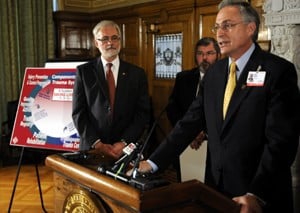UAMS Medical Center Becomes First in State Designated Level I Trauma Center
Sept. 28, 2010 | The trauma program in the University of Arkansas for Medical Sciences (UAMS) Medical Center is now first in the state to achieve Level I designation from the Arkansas Department of Health as providing the highest level of trauma care. “We were the only state that didn’t have a Level I trauma center and one of only three states without a trauma system. Those are statistics we don’t like,” said Gov. Mike Beebe during a news conference today to announce the initial trauma center designations. UAMS received the designation following an August survey by the state health department, which is administering the new statewide trauma system. At the top of the system for coordinating emergency care in the state, Level I trauma centers must have specialized surgeons on duty at all times to quickly care for the most serious and urgent cases. In addition to the UAMS designation, the Regional Medical Center in Memphis, Tenn., was designated a Level I center and Jefferson Regional Medical Center in Pine Bluff was designated a Level II center. The three centers are the first of 73 that have indicated they will be a part of the new system, according to the state Department of Health. The UAMS program includes board-certified emergency medicine physicians and surgeons. UAMS trauma services include a state-of-the-art Emergency Department with 34 private patient rooms that opened in 2009 along with a major hospital expansion. The department also features a general X-ray room and a computed tomography (CT) scanner, eliminating the need to transport trauma patients for imaging. “The Level I designation reflects hard work by our trauma program and hospital to be a catalyst for improving trauma care in Arkansas,” said Richard Pierson, UAMS vice chancellor for clinical programs and UAMS Medical Center executive director. “Our trauma program encompasses a broad, multi-disciplinary approach to patient care that builds on a foundation of our skilled professionals and our facilities.” Level I centers also must include education, preventive and outreach programs as well as a program of trauma research. UAMS education programs include hosting regular symposiums for health care professionals across the state on new emergency medicine techniques or refresher courses on trauma practices. A patient referral call center and extensive telemedicine network with rural hospitals are among UAMS trauma outreach efforts. UAMS leads or participates in numerous injury prevention programs including youth accident prevention programs, the anti-drunk driving program Prom Promise, driver safety programs for older drivers and car seat safety education. “Achieving the Level I designation represents an institution wide commitment when you consider the education, research and outreach efforts with the patient care element, which fits with the UAMS mission to improve the health of all Arkansans,” said UAMS Chancellor Dan Rahn, M.D. “A coordinated statewide trauma system will save lives by getting injured patients to the care they need more quickly.” The statewide trauma system, expected to be operational in 2011, will connect hospitals, ambulance services and other emergency responders statewide to transfer trauma patients as quickly as possible to the facility best able to treat their specific injuries. Four levels of trauma designations for Arkansas hospitals will denote the kinds of resources available in a trauma center and the number of patients admitted yearly. Injuries remain the leading cause of death for adults and children ages 1-44. The U.S. Centers for Disease Control said for those with severe injuries, getting to a Level I trauma center can lower the risk of death by 25 percent. In Arkansas, the death rate for all injuries has been consistently higher than the national average. A 2008 report by the American College of Surgeons said the overall injury fatality rate in Arkansas is nearly 50 percent higher than the national average, and the injury fatality rate for motor vehicle crashes (the second most common injury mechanism in the state) is 60 percent higher than the national average. In 2005, Arkansas ranked 50th in the nation for timely trauma center accessibility. There were 6,411 trauma-related visits to the UAMS Emergency Department out of 51,246 patient visits from June 1, 2009 through May 31, 2010. The number of UAMS trauma patients admitted to the hospital has increased more than 140 percent, from 720 to 1,756 between fiscal years 2004 and 2010. Act 393, which established the trauma system, was approved by the state Legislature in 2009 and signed into law by Gov. Mike Beebe on March 13, 2009. The UAMS Level I designation is for four years, after which there will be a survey for renewal. |
